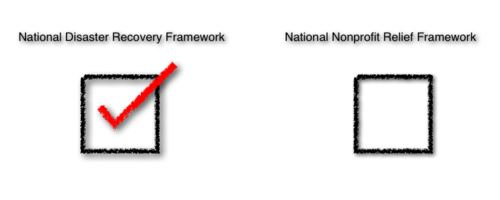Longform: We Can’t do it Alone = We Need a Plan
http://billdriscolljr.tumblr.com/
The reality of disaster recovery is that no one person, government agency, or voluntary organization can do it alone. This staggering and sobering realization for survivors and responders alike, comes consistently post disaster.Recently the concern and potential complications created by the threat of augmenting Federal disaster funds had been consistently in news. Federal budget negotiations seemed to be fixated around disaster recovery dollars. While Federal support can be critical to disaster recovery for both individuals and municipalities, many disasters in the United States go “undeclared”, meaning that they are smaller in size and do not meet the criteria for a Presidential declaration and the accompanying Federal support. We do know the answer to the questions “what if FEMA support isn’t available?” and “what would the recovery look like?”When a disaster goes “undeclared” and does not generate a Presidential declaration, the burden of recovery falls on individuals themselves, any insurance settlement, available state programs and available charitable or voluntary organization support. That said, even in a Federally declared disaster area, non governmental organizations (NGOs) and community based organizations, faith based or not, still provide many of the missing pieces of a disaster survivor’s recovery. FEMA’s own “sequence of delivery” literally begins and ends with voluntary agencies. [See herehttp://www.fema.gov/pdf/about/regions/regioni/sequence2008.pdf]Amidst the recent budget posturing in Congress, FEMA released the National Disaster Recovery Framework (NDRF), which details “the plan” for future Federal support to state recovery operations. A clearer and updated national plan for the delivery of government related disaster recovery operations is a welcome and important addition to the disaster response and recovery community. That said, no sooner than we can pat those on the back that participated in and crafted the NDRF do we need to focus on what still lacks within this dedicated and passionate community (Full disclosure: I participated in a stakeholders session). The disaster recovery community is comprised of not only government responders but an inspired lot of nonprofit and faith based NGOs.There is no equivalent to the NDRF for the NGOs active in disaster work and yet this is the part of the community that most consistently engages to help survivors post disaster. The needs that are generated by disaster (even those that do not receive official Federal designation) compel most NGO operations to action, many of which are volunteer and donor driven.For me, someone that is engaged in disaster response and recovery on a daily basis in the charitable and nonprofit sector, the lack of a consistent field-wide plan or framework is apparent at every disaster event I deploy to. There continues to be lack of consistently agreed upon or valuable structure for NGO coordination both from a distance and on the ground. I believe focusing on an NGO-centric complimentary plan to the National Disaster Recovery Framework needs to be a top priority for the entire disaster response and recovery community. The discussion, research and development of a “parallel” plan began a few years ago but the process to create what is known as the “National Nonprofit Relief Framework” has been stuck in neutral. Its originally targeted release date of December 2010 has come and gone. The BP oil spill in 2010 and 2011’s six months of what seemed like nonstop tornadoes, floods, and tropical storms have played a major role in the stall. We as a community have been quite busy…Many NGOs that are national in scope and have disaster related programs are members of coalitions like National Voluntary Organizations Active (National VOAD) in the hopes that greater communication will lead to collaborative partnerships. National VOAD and the numerous related state level forums are fantastic and beneficial but they are by design, right or wrong, not operational in nature. The members’ relationships and values within the National VOAD community, however, can and will help spawn a renewed effort for a nonprofit relief / recovery framework. Tremendous amounts of aid and hope are delivered by a diverse group of VOAD and NGO partners at each disaster. The potential to do more by strategically pooling resources under the framework of a tactically coordinated plan will only serve to grow the efficiency and effectiveness of our already impressive community. The potential growth is exciting.I hope the NDRF completion brings new light and enthusiasm to complete, “whole community” planning through renewed focus on the means by which nonprofits and NGOs collaborate in disasters alongside resources brought to bear by Federal down to local level government.As expressed by the outpouring of charitable giving by donors following tragedy and disaster, we collectively seem to understand the norm that donated dollars are different than Federal ones and can be utilized and dispersed for varied and perhaps no less effective reasons. Simply no one agency whether or public or private can do it alone. As such we should be constantly driving toward enhancing and improving the way we coordinate and collaborate pre and post disaster.We in nonprofits are at the mercy of proving that donations are being spent effectively and efficiently. In order to improve our current collective measures we should move with vigor toward a comprehensive and consistent recovery coordination framework so we are better prepared the next time disaster strikes our country.

No comments :
Post a Comment